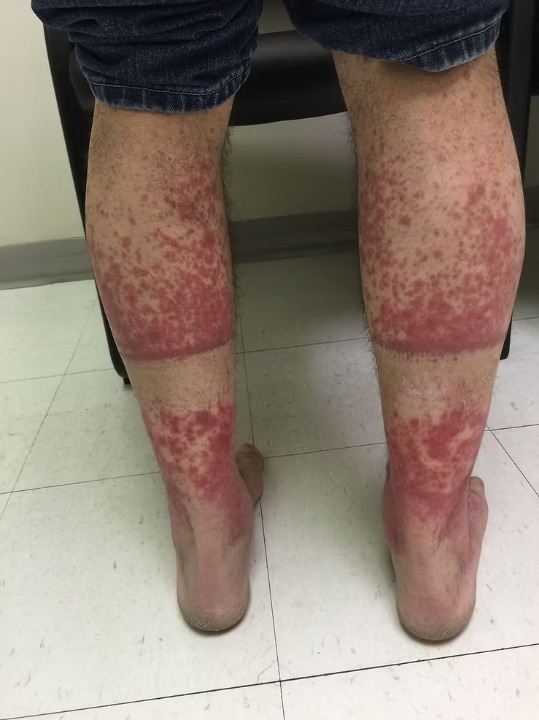When you’re out enjoying a warm day—whether strolling through a city, hiking, sightseeing on vacation, or even standing for long hours—you may sometimes notice a reddish or purplish rash forming on your legs afterward. At first, it may look like a sunburn, bug bites, or even a mild allergic reaction. But in many cases, it’s actually something known as exercise-induced vasculitis (EIV).
This condition is generally mild, but it can cause discomfort, concern, and confusion because it resembles other skin or vascular problems. Understanding what triggers it, how to recognize the signs, and what you can do to find relief can help reduce unnecessary worry and improve your quality of life during warm-weather activities.
What Exactly Is Exercise-Induced Vasculitis?
Exercise-induced vasculitis, sometimes nicknamed “golfer’s vasculitis”, “Disney rash”, or “hiker’s rash”, is a temporary inflammatory response that affects the small blood vessels near the skin’s surface.
It typically appears after:
- Prolonged walking, hiking, or exercise
- Exposure to hot or humid environments
- Activities where blood tends to pool in the legs due to gravity
The main visible sign is a rash—usually red, purple, or blotchy—that appears around the lower legs, particularly just above the sock line. Some people describe it as patchy or speckled, while others notice larger areas of discoloration.
While the name sounds serious, it’s usually a benign condition. The main issue is discomfort, such as itching, burning, or swelling, rather than long-term harm. Still, because it resembles more severe illnesses, knowing what it is (and what it isn’t) is important.
Why Does It Happen?
The exact reason some people experience exercise-induced vasculitis while others don’t isn’t fully understood, but several factors contribute:
- Heat Stress
- On hot days, blood vessels naturally expand (dilate) to help the body release heat.
- This process increases blood flow near the skin’s surface.
- Gravity and Blood Pooling
- When standing or walking for long periods, blood tends to collect in the lower legs.
- If circulation doesn’t return the blood efficiently to the heart, tiny vessels in the skin can become irritated.
- Inflammation of Capillaries
- Small blood vessels (capillaries) may swell and leak small amounts of blood under the skin.
- This leakage creates the reddish or purplish rash seen in EIV.
- Individual Sensitivity
- Some people’s vascular systems are more prone to reacting in this way, especially older adults and women.
Who Is More Likely to Experience It?
While anyone can develop EIV, certain groups are more commonly affected:
- Adults over 50 – Blood vessel elasticity decreases with age, making pooling more likely.
- Women – Especially those who are physically active outdoors.
- Travelers – Cruise ship passengers often report it after sightseeing in hot climates.
- Outdoor enthusiasts – Golfers, hikers, and festival-goers are frequent cases.
It’s not rare, but because many dismiss it as a simple irritation, it often goes underreported.
Recognizing the Symptoms
The rash of exercise-induced vasculitis usually develops a few hours after activity in heat and may last several days. Common symptoms include:
- Itchy, tingling, or burning sensations in the lower legs
- Red or purple blotches or patches that do not fade immediately when pressed
- Mild swelling in the ankles or calves
- Discomfort when standing for long periods
In most cases, the rash lasts 7–10 days, gradually fading as circulation improves and the body cools down.
Is It Dangerous?
For most people, the answer is no. Exercise-induced vasculitis is usually harmless and self-limiting. It does not cause long-term vascular damage and rarely requires medical treatment.
However, the challenge is that it resembles more serious conditions, such as infections or systemic illnesses. This can lead to either:
- Unnecessary anxiety (thinking it’s worse than it is), or
- Delayed treatment if the rash is actually something else more serious.
That’s why it’s important to know the differences.
Conditions That Can Look Similar
Other conditions can mimic the appearance of exercise-induced vasculitis:
- Cellulitis – A bacterial skin infection, usually affecting one leg, accompanied by pain, warmth, swelling, and sometimes fever. Requires antibiotics.
- Folliculitis – Infection of hair follicles, appearing as clusters of small red bumps, sometimes with pus. Often linked to hot tubs or shaving.
- Meningitis – A serious medical emergency. A non-blanching rash with fever, headache, and stiff neck may indicate meningitis and needs urgent care.
- Sepsis – Widespread infection in the body can cause pinpoint rashes along with fever, chills, confusion, and rapid breathing.
- Measles or viral rashes – Generalized rashes with fever and respiratory symptoms, most concerning in unvaccinated individuals.
If symptoms include pain, fever, spreading redness, or systemic illness, it’s time to seek medical care rather than assume it’s EIV.
Finding Relief: Home Remedies and Self-Care
Most people manage symptoms at home. Effective strategies include:
- Cool compresses – Applying a damp cloth can reduce heat and soothe itching.
- Leg elevation – Raising legs above heart level improves circulation and reduces swelling.
- Hydration – Drinking enough fluids supports blood vessel function.
- Mild antihistamines – Over-the-counter options can help reduce itching.
What to Avoid
Some things can make symptoms worse:
- Prolonged sun exposure after the rash starts
- Soaking in hot baths or hot tubs
- Continuing intense exercise in the heat
- Applying irritating creams, muscle rubs, or unnecessary antibiotics
Prevention Tips
While there’s no guaranteed way to prevent EIV, you can reduce your chances:
- Wear lightweight, breathable clothing
- Use compression socks (though some find them uncomfortable)
- Take breaks in shade or air-conditioned spaces during long walks
- Stay well-hydrated before and during exercise
- Exercise during cooler times such as morning or evening
Living with Exercise-Induced Vasculitis
For many people, EIV is more of an inconvenience than a medical problem. Knowing how to recognize it helps reduce unnecessary stress. With planning, you can still enjoy outdoor activities without significant disruption.
Lifestyle tips include:
- Choosing cooler environments for physical activity
- Alternating sitting and standing during long outings
- Listening to your body and resting when discomfort starts
Frequently Asked Questions
1. Does EIV cause permanent damage?
No, it’s generally temporary and leaves no lasting effects.
2. Should I stop exercising if I get this rash?
You don’t need to stop all activity, but resting until symptoms fade is recommended.
3. Can children develop it?
It’s less common, but possible. More often reported in adults.
4. Do I need medication?
Most cases improve without prescription medication.
5. How long does recovery take?
Typically within a week to ten days.
When to Seek Medical Care
See a healthcare provider if:
- The rash spreads rapidly or worsens
- It’s painful, warm, or associated with fever
- You feel unwell overall
- You are uncertain if it’s vasculitis or another condition
Conclusion
Exercise-induced vasculitis may appear dramatic, but it’s generally mild and temporary. It occurs when small blood vessels in the lower legs become inflamed after long activity in hot conditions. The resulting rash can cause itching, burning, or swelling, but usually resolves within a week.
By recognizing the condition, practicing self-care, and taking preventive measures, most people can continue to enjoy outdoor activities without worry. And while it rarely requires medical attention, staying alert to warning signs of more serious illnesses ensures peace of mind and safety.
Your body often gives subtle signals, and this rash is one of them. Listening, adjusting, and taking care of yourself is the best way forward.




